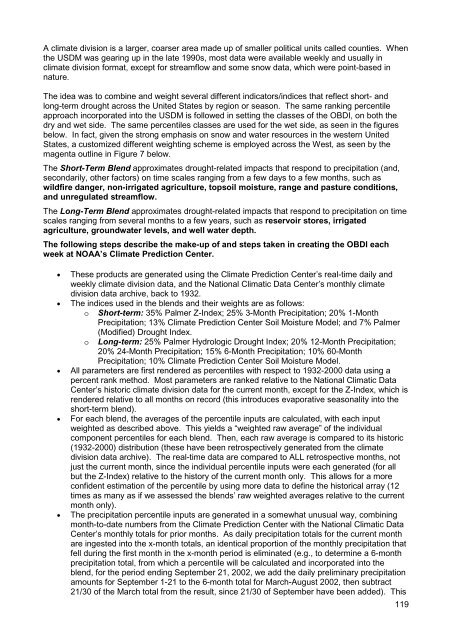Agricultural Drought Indices - US Department of Agriculture
Agricultural Drought Indices - US Department of Agriculture
Agricultural Drought Indices - US Department of Agriculture
Create successful ePaper yourself
Turn your PDF publications into a flip-book with our unique Google optimized e-Paper software.
A climate division is a larger, coarser area made up <strong>of</strong> smaller political units called counties. When<br />
the <strong>US</strong>DM was gearing up in the late 1990s, most data were available weekly and usually in<br />
climate division format, except for streamflow and some snow data, which were point-based in<br />
nature.<br />
The idea was to combine and weight several different indicators/indices that reflect short- and<br />
long-term drought across the United States by region or season. The same ranking percentile<br />
approach incorporated into the <strong>US</strong>DM is followed in setting the classes <strong>of</strong> the OBDI, on both the<br />
dry and wet side. The same percentiles classes are used for the wet side, as seen in the figures<br />
below. In fact, given the strong emphasis on snow and water resources in the western United<br />
States, a customized different weighting scheme is employed across the West, as seen by the<br />
magenta outline in Figure 7 below.<br />
The Short-Term Blend approximates drought-related impacts that respond to precipitation (and,<br />
secondarily, other factors) on time scales ranging from a few days to a few months, such as<br />
wildfire danger, non-irrigated agriculture, topsoil moisture, range and pasture conditions,<br />
and unregulated streamflow.<br />
The Long-Term Blend approximates drought-related impacts that respond to precipitation on time<br />
scales ranging from several months to a few years, such as reservoir stores, irrigated<br />
agriculture, groundwater levels, and well water depth.<br />
The following steps describe the make-up <strong>of</strong> and steps taken in creating the OBDI each<br />
week at NOAA’s Climate Prediction Center.<br />
• These products are generated using the Climate Prediction Center’s real-time daily and<br />
weekly climate division data, and the National Climatic Data Center’s monthly climate<br />
division data archive, back to 1932.<br />
• The indices used in the blends and their weights are as follows:<br />
o Short-term: 35% Palmer Z-Index; 25% 3-Month Precipitation; 20% 1-Month<br />
Precipitation; 13% Climate Prediction Center Soil Moisture Model; and 7% Palmer<br />
o<br />
(Modified) <strong>Drought</strong> Index.<br />
Long-term: 25% Palmer Hydrologic <strong>Drought</strong> Index; 20% 12-Month Precipitation;<br />
20% 24-Month Precipitation; 15% 6-Month Precipitation; 10% 60-Month<br />
Precipitation; 10% Climate Prediction Center Soil Moisture Model.<br />
• All parameters are first rendered as percentiles with respect to 1932-2000 data using a<br />
percent rank method. Most parameters are ranked relative to the National Climatic Data<br />
Center’s historic climate division data for the current month, except for the Z-Index, which is<br />
rendered relative to all months on record (this introduces evaporative seasonality into the<br />
short-term blend).<br />
• For each blend, the averages <strong>of</strong> the percentile inputs are calculated, with each input<br />
weighted as described above. This yields a “weighted raw average” <strong>of</strong> the individual<br />
component percentiles for each blend. Then, each raw average is compared to its historic<br />
(1932-2000) distribution (these have been retrospectively generated from the climate<br />
division data archive). The real-time data are compared to ALL retrospective months, not<br />
just the current month, since the individual percentile inputs were each generated (for all<br />
but the Z-Index) relative to the history <strong>of</strong> the current month only. This allows for a more<br />
confident estimation <strong>of</strong> the percentile by using more data to define the historical array (12<br />
times as many as if we assessed the blends’ raw weighted averages relative to the current<br />
month only).<br />
• The precipitation percentile inputs are generated in a somewhat unusual way, combining<br />
month-to-date numbers from the Climate Prediction Center with the National Climatic Data<br />
Center’s monthly totals for prior months. As daily precipitation totals for the current month<br />
are ingested into the x-month totals, an identical proportion <strong>of</strong> the monthly precipitation that<br />
fell during the first month in the x-month period is eliminated (e.g., to determine a 6-month<br />
precipitation total, from which a percentile will be calculated and incorporated into the<br />
blend, for the period ending September 21, 2002, we add the daily preliminary precipitation<br />
amounts for September 1-21 to the 6-month total for March-August 2002, then subtract<br />
21/30 <strong>of</strong> the March total from the result, since 21/30 <strong>of</strong> September have been added). This<br />
119

















